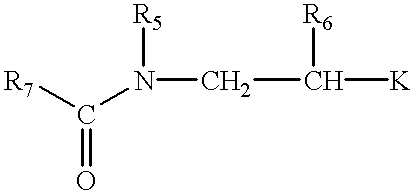Personal care formulations
a formulation and personal care technology, applied in the field of personal care formulations, can solve the problems of difficult formulation of microemulsions, difficult to form microemulsions, and difficult to dissolve compositions in water to form microemulsions, etc., to enhance the appearance, feel and fragrance of the skin
- Summary
- Abstract
- Description
- Claims
- Application Information
AI Technical Summary
Benefits of technology
Problems solved by technology
Method used
Image
Examples
example 1
[0158] The following formulas were made in accordance with the teachings of this invention:
1 Formulation (% by wt.) A B Surfactant Phase EMPICOL 0251 / 70J 10.29 0.0 EMPIGEN CDL 30 / J / 35 0.0 9.51 EMPIGEN BB 2.94 7.28 EMPICOL CED 5 S 5.65 0.0 EMPICOL 0758 0.0 1.94 EMPILAN KB12 4.90 0.0 EMPILAN KB6 0.0 0.0 EMPILAN KB2 6.86 7.77 Sodium Chloride 1.96 0.0 Glycerol 1.96 0.0 47% NaOH 0.20 0.0 EDTA 0.10 0.10 Citric Acid 0.20 0.19 Sodium Benzoate 0.29 0.29 Water 38.18 46.71 Oil Phase Salicylic Acid 1.96 1.94 KRISTOL M70 24.51 24.27 Viscosity (cs) of Oil Phase 70 70 HLB of Oil Phase 11 11 Salicylic Acid Deposition 2.5 ug / cm2 1.2 ug / cm2
[0159] As demonstrated by this example, by varying the amount and types of surfactant the amount of deposition can be significantly increased. When formulation A, containing less amphoteric surfactant, was compared to formulation B, the amount of deposition for formulation A was significantly increased.
example 2
[0160]
2 Formulation (% by wt.) C D Surfactant Phase EMPICOL 0251 / 70J 10.24 10.59 EMPIGEN BB 2.93 3.03 EMPICOL CED 55 5.62 5.81 Sodium Chloride 1.95 2.02 Glycerol 1.95 2.02 47% NaOH 0.20 0.20 EDTA 0.10 0.10 Citric Acid 0.20 0.20 Sodium Benzoate 0.29 0.30 EMPILAN KB2 4.88 5.05 EMPILAN KB12 4.88 5.05 Water 47.73 44.64 Oil Phase Salicylic Acid 1.95 2.02 MIGLYOL 812S 4.88 5.41 KRISTOL M70 12.20 13.51 Viscosity (cs) of Oil Phase 55 70 HLB of Oil Phase 11 11 Salicylic Acid Deposition 1.6 ug / cm2 2.3 ug / cm2
[0161] As demonstrated above, a significant increase was observed in the salicylic acid deposition with formulation D having an extra 2% of Oil. While not wishing to be bound by theory, this increase in oil level is expected to increase the availability of the oil / salicylic acid mixture to the surface of the skin. It also could be due to changes in the viscosity of the oil phase and the surfactant packing phase, which would also increase the availability of the oil / salicylic acid mixture t...
example 3
[0162]
3 Formulation (% by wt.) E F Surfactant Phase EMPICOL 0251 / 70J 10.24 8.88 EMPIGEN BB 2.93 2.54 EMPICOL CED 55 5.62 4.87 Sodium Chloride 1.95 1.69 Glycerol 1.95 1.69 47% NaOH 0.20 0.17 EDTA 0.10 0.08 Citric Acid 0.20 0.17 Sodium Benzoate 0.29 0.25 EMPILAN KB12 4.88 4.23 EMPILAN KBE2 4.88 4.23 Water 47.73 52.43 Oil Phase Salicylic Acid 1.95 1.69 CCT oil 4.88 4.88 HMO oil 12.20 12.20 Viscosity (cs) of Oil Phase 55 55 HLB of Oil Phase 11 11 Salicylic Acid Deposition 1.9 ug / cm2 2.2 ug / cm2
[0163] As demonstrated above, a significant increase was observed in the salicylic acid deposition with the sample with the additional added water.
PUM
| Property | Measurement | Unit |
|---|---|---|
| temperature | aaaaa | aaaaa |
| temperature | aaaaa | aaaaa |
| temperature | aaaaa | aaaaa |
Abstract
Description
Claims
Application Information
 Login to View More
Login to View More - R&D
- Intellectual Property
- Life Sciences
- Materials
- Tech Scout
- Unparalleled Data Quality
- Higher Quality Content
- 60% Fewer Hallucinations
Browse by: Latest US Patents, China's latest patents, Technical Efficacy Thesaurus, Application Domain, Technology Topic, Popular Technical Reports.
© 2025 PatSnap. All rights reserved.Legal|Privacy policy|Modern Slavery Act Transparency Statement|Sitemap|About US| Contact US: help@patsnap.com

